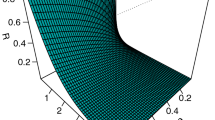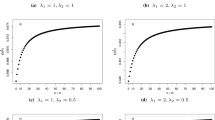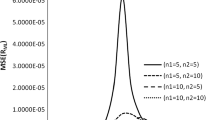Abstract
The stress-strength reliability \(R=P(Y<X)\), where \(X\) and \(Y\) are independent continuous random variables, has obtained wide attention in many areas of application, such as in engineering statistics and biostatistics. Classical likelihood-based inference about \(R\) has been widely examined under various assumptions on \(X\) and \(Y\). However, it is well-known that first order inference can be inaccurate, in particular when the sample size is small or in presence of unknown parameters. The aim of this paper is to illustrate higher-order likelihood-based procedures for parametric inference in small samples, which provide accurate point estimators and confidence intervals for \(R\). The proposed procedures are illustrated under the assumptions of Gaussian and exponential models for \((X,Y)\). Moreover, simulation studies are performed in order to study the accuracy of the proposed methodology, and an application to real data is discussed. An implementation of the proposed method in the R software is provided.


Similar content being viewed by others
References
Bamber D (1975) The area above the ordinal dominance graph and the area below the receiver operating characteristic graph. J Math Psychol 12:387–415
Barndorff-Nielsen OE (1983) On a formula for the distribution of the maximum likelihood estimator. Biometrika 70:343–365
Barndorff-Nielsen OE (1991) Modified signed log likelihood ratio. Biometrika 78:557–563
Barndorff-Nielsen OE, Chamberlin S (1994) Stable and invariant adjusted directed likelihoods. Biometrika 81:485–499
Barndorff-Nielsen OE, Cox DR (1994) Inference and asymptotics. Chapman and Hall, London
Brazzale AR, Davison AC, Reid N (2007) Applied asymptotics. Case-studies in small sample statistics. Cambridge University Press, Cambridge
Efron B, Hinkley D (1978) Assessing the accuracy of the maximum likelihood estimator: observed versus expected Fisher information. Biometrika 65:457–482
Faraggi D (2000) The effect of random measurement error on receiver operating characteristic (ROC) curves. Stat Med 19:61–70
Fraser DAS, Reid N, Wu J (1999) A simple general formula for tail probabilities for frequentist and Bayesian inference. Biometrika 86:249–264
Giummolé F, Ventura L (2002) Practical point estimation from higher-order pivots. J Stat Comput Simul 72:419–430
Guttman I, Johnson RA, Bhattacharyya GK, Reiser B (1988) Confidence limits for stress-strength models with explanatory variables. Technometrics 30:161–168
Hanley JA (1989) Receiver operating characteristic (ROC) methodology: the state of the art. Crit Rev Diagn Imaging 29:307–335
Jiang L, Wong ACM (2008) A note on inference for \(P(X<Y)\) for right truncated exponentially distributed data. Stat Pap 49:637–651
Kotz S, Lumelskii Y, Pensky M (2003) The stress-strength model and its generalizations. Theory and applications. World Scientific, Singapore
Newcombe RG (1998) Two-sided confidence intervals for the single proportion: comparison of seven methods. Stat Med 17:857–872
Obuchowski NA, Lieber ML (1998) Confidence intervals for the receiver operating characteristic area in studies with small samples. Acad Radiol 5:561–571
Pace L, Salvan A (1997) Principles of statistical inference. World Scientific, Singapore
Pace L, Salvan A (1999) Point estimation based on confidence intervals. J Stat Comput Simul 64:1–21
R Development Core Team (2010) R: a language and environment for statistical computing. R Foundation for Statistical Computing, Vienna, Austria. ISBN 3-900051-07-0, http://www.R-project.org
Reid N, Fraser DAS (2010) Mean likelihood and higher order approximations. Biometrika 97:159–170
Reiser B (2000) Measuring the effectiveness of diagnostic markers in the presence of measurement error through the use of ROC curves. Stat Med 19:2115–2129
Reiser B, Faraggi D (1997) Confidence intervals for the generalized ROC criterion. Biometrics 53:644–652
Schisterman EF, Faraggi D, Reiser B (2004) Adjusting the generalized ROC curve for covariates. Stat Med 23:3319–3331
Severini TA (1999) An empirical adjustment to the likelihood ratio statistic. Biometrika 86:235–247
Severini TA (2000) Likelihood methods in statistics. Oxford University Press, New York
Skovgaard IM (1996) A general large deviation approximation to one parameter tests. Bernoulli 2:145–165
Wolfe DA, Hogg RV (1971) On constructing statistics and reporting data. Am Stat 25:27–30
Zweig MH, Campbell G (1993) Receiver-operating characteristic (ROC) plots: a fundamental evaluation tool in clinical medicine. Clin Chem 39:561–577
Acknowledgments
This research was supported by grants from MIUR, and from University of Padova (Progetto di Ateneo 2011), Italy. The authors thank the Referees and the Associate Editor for their useful comments and suggestions, which lead to an improved version of the paper.
Author information
Authors and Affiliations
Corresponding author
Appendices
Appendix A: Computation of statistics for the Gaussian and exponential models
Under the assumption of Gaussian distributions with equal variances for \(Y\) and \(X\) as described in Sect. 3.1, in order to compute the Wald statistic, the profile observed information is obtained from (5). Its expression is
where \(\hat{G} =2 n n_1 n_2 \hat{\lambda }_2^2 \hat{d}^2\), with \(\hat{d} = \partial \varPhi ^{-1}(\hat{\psi })/\partial \hat{\psi }= 1/\phi (\varPhi ^{-1}(\hat{\psi }))\) and \(\phi (\cdot )\) standard normal probability density function.
In the same example, for computing the adjustment term \(q\) of the \(r_p^*\) statistic, given in (7), we have
with \(\hat{B} = \hat{\lambda }_1 \hat{\lambda }_2 -D(\hat{\theta })\), \(\hat{C} = n_1 \hat{\lambda }_1 \hat{\lambda }_2 + n_2 D(\hat{\theta })\) and \(\hat{F} = n_1\tilde{\lambda }_1 \tilde{\lambda }_2 \hat{\lambda }_1 \hat{\lambda }_2 + n_2 D(\hat{\theta }) D(\hat{\theta }_{\psi })\). The tilde above the parameters indicates an estimate constrained to a fixed \(\psi \), while the hat indicates an MLE estimate. The sample space derivatives needed for computing the \(q\) term are
with \(K= \partial \varPhi ^{-1} (\hat{\psi }) / \partial \hat{\psi }\).
The sample space derivatives \( \ell _{;\hat{\lambda }}(\hat{\theta }_\psi ) = ( \ell _{;\hat{\lambda }_1}, \ \ell _{;\hat{\lambda }_2} ) \) are computed as
while \( \ell _{\lambda ;\hat{\psi }}(\hat{\theta }_\psi ) = ( \ell _{\lambda _1;\hat{\psi }}, \ \ell _{\lambda _2;\hat{\psi }} ) \) are given as
with \(b = \varPhi ^{-1} (\psi ) + \tilde{\lambda }_1 \).
The quantity \( \ell _{\lambda ;\hat{\lambda }}(\hat{\theta }_\psi )\) is equal to the \((d-1) \) square matrix
The sample space derivatives therein can be computed from the full likelihood function
which only depends on the MLE estimates and the parameter \(\theta \). Thus, we have
Appendix B: Implementation in R
We present the R code for the estimation of \(R\) under a parametric setting. Continuous quantities of interest can be assumed as exponential variables or Gaussian variables with either equal or different variances. The R package ProbYX can be downloaded from the webpage http://homes.stat.unipd.it/gcortese under the heading ‘Software’.
The two data sets from two different populations are called, respectively, ydat and xdat. MLEs for the parameter of interest \(\psi \) and the nuisance parameter \(\lambda \) can be obtained from the following code
MLEs(ydat,xdat,distr),
where distr can be set equal to either "exp", "norm_EV" or "norm_DV", according as the distributions assumed for the continuous markers are exponential or Gaussian with equal or unequal variances, respectively. The log-likelihood can be computed for a given set of values of \(\psi \) and \(\lambda \) by means of the function
loglik(ydat,xdat,lambda,psi,distr),
where lambda and psi are, respectively, \(\lambda \) and \(\psi \). For the case of Gaussian distributions with different variances the following simpler reparameterisation has been used
with \(\sigma _1^2\), \(\sigma _2^2\) variances of the Gaussian variables \(Y\) and \(X\), respectively.
Point estimates and confidence intervals for \(R\) are obtained by using the R function Prob as follows:
Prob(ydat,xdat,distr,method,level),
where the argument method, set to be equal to either “Wald”, “RP” or “RPstar”, allows to choose confidence intervals based on the Wald, \(r_p\) or \(r_p^*\) statistic, respectively (see formula (3) and (4) and Sect. 3). When the methods “Wald” or “RP” are selected, point estimate for \(\psi \) corresponds to the MLE, while the method “RPstar” yields the \(r_p^*\)-based point estimate for \(\psi \) as presented in Sect. 3. The confidence level \((1-\alpha )\) can be decided by setting level \(=\alpha \).
The Wald, \(r_p\) and \(r_p^*\) statistics can also be computed for a given value of \(\psi \) by applying, respectively, the R functions
-
\({\mathtt {w <- wald(ydat,xdat,psi,distr)} },\)
-
\({\mathtt {r <- rp(ydat,xdat,psi,distr)} },\)
-
\({\mathtt {r\_star <- rpstar(ydat,xdat,psi,distr)} }\).
The steps 4–6, given at the end of Sect. 3, for application of the higher-order procedures based on the signed log-likelihood ratio statistic \(r_p^*\), can be implemented by means of the following R commands:
-
\({\mathtt {smoother <- smooth.spline(V.r\_star,r\_star.range)} }\)
-
\({\mathtt {psi1 <- predict(smoother,z1)\$y} }\)
-
\({\mathtt {psi2 <- predict(smoother,z2)\$y} }\)
-
\({\mathtt {hatpsi <- predict(smoother,0)\$y} }\)
where V.r_star is the vector of values of \(r_p^*\), r_star, calculated by applying the R function rpstar repeatedly on an appropriate range r_star.range of values of \(\psi \), psi1 and psi2 are the limits \(\psi ^*_1\) and \(\psi ^*_2\) of the confidence interval corresponding to the percentiles z1 \(=z_{1-\alpha /2}\) and z2 \(=z_{\alpha /2}\), and hatpsi is the point estimate \(\hat{\psi }^*\).
Rights and permissions
About this article
Cite this article
Cortese, G., Ventura, L. Accurate higher-order likelihood inference on \(P(Y<X)\) . Comput Stat 28, 1035–1059 (2013). https://doi.org/10.1007/s00180-012-0343-z
Received:
Accepted:
Published:
Issue Date:
DOI: https://doi.org/10.1007/s00180-012-0343-z




